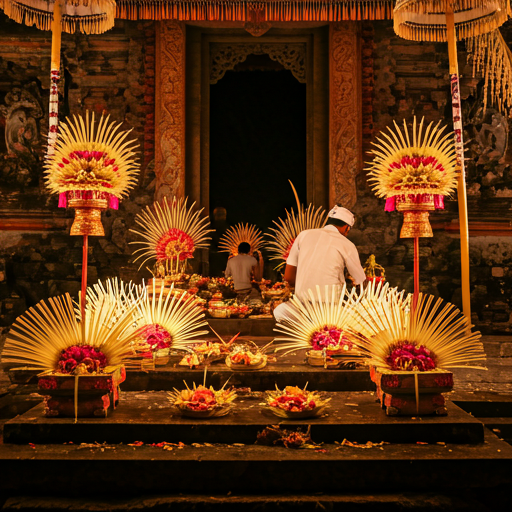In the mystical island of Bali, where emerald rice terraces meet ancient temples, blessing ceremonies form the spiritual heartbeat of daily life. These sacred rituals, passed down through generations, weave together the physical and spiritual realms in a tapestry of devotion, community, and profound meaning. For the Balinese people, these ceremonies aren’t merely religious obligations—they’re essential expressions of harmony between humans, nature, and the divine.
The Philosophy Behind Balinese Blessings
At the core of Balinese Hinduism lies the concept of Tri Hita Karana—the three sources of harmony and prosperity. This philosophy emphasizes maintaining balance between humans and God (Parahyangan), humans and their fellow humans (Pawongan), and humans and nature (Palemahan). Blessing ceremonies serve as practical manifestations of this philosophy, helping the Balinese maintain these crucial relationships.
The Balinese calendar, known as Pawukon, determines the timing of these ceremonies. Unlike the Gregorian calendar, it consists of multiple concurrent weeks of different lengths, creating a complex system that priests and cultural experts carefully navigate to select auspicious dates for ceremonies.
Common Types of Blessing Ceremonies
Melukat: The Purification Ritual
Perhaps the most frequently performed blessing ceremony is Melukat, a purification ritual that cleanses both body and soul. Performed at sacred water temples or holy springs, participants undergo a series of ritual baths while reciting mantras and offering prayers. The ceremony begins before dawn, when the veil between the physical and spiritual worlds is believed to be thinnest.
The holy water used in Melukat, called tirta, is collected from sacred springs and blessed by priests. Participants dress in traditional clothing—a sarong and sash—and bring offerings of flowers, incense, and canang sari (small palm-leaf baskets filled with flowers, rice, and other symbolic items).
Galungan and Kuningan
These major festivals, occurring every 210 days, represent the victory of dharma (good) over adharma (evil). During Galungan, elaborate penjor—decorated bamboo poles—line the streets, while families gather for blessing ceremonies at temples and ancestral homes. The celebrations conclude with Kuningan ten days later, when ancestors are believed to return to their celestial abode.
Baby Blessing Ceremonies
The Balinese mark significant milestones in a child’s life with specific blessing ceremonies. The three-month ceremony (Telung Bulanan) is particularly important, marking the time when a baby first touches the ground. A high priest conducts elaborate rituals, and family members gather to witness this crucial transition in the child’s spiritual journey.
Elements of a Traditional Blessing Ceremony
Sacred Offerings
Central to any Balinese blessing ceremony are the meticulously crafted offerings, or banten. These artistic arrangements of flowers, fruits, rice, and other natural elements serve as symbolic bridges between the physical and spiritual worlds. Creating these offerings is an art form itself, requiring deep knowledge of traditional techniques and symbolic meanings.
Common elements include:
- Fresh flowers representing purity and divine beauty
- Rice as a symbol of prosperity and sustenance
- Fruits symbolizing nature’s abundance
- Incense smoke carrying prayers heavenward
- Holy water (tirta) for purification
The Role of the Pemangku
A pemangku, or temple priest, plays an essential role in blessing ceremonies. These spiritual leaders undergo years of training to master the complex rituals, mantras, and offerings required for different ceremonies. Unlike high priests (pedanda), pemangku often serve specific communities or temples and maintain regular jobs alongside their spiritual duties.
Musical Accompaniment
The gamelan orchestra, with its distinctive metallophones, gongs, and drums, provides the sacred soundtrack for many blessing ceremonies. The music isn’t merely entertainment—it’s believed to please the gods and create an appropriate atmosphere for spiritual communion. Different ceremonies require specific musical compositions, each with its own spiritual significance.
Modern Adaptations and Tourism Impact
While Balinese blessing ceremonies remain deeply rooted in tradition, they haven’t been immune to modern influences and the impact of tourism. Many hotels and spas now offer simplified blessing ceremonies for visitors, raising questions about cultural authenticity and commercialization.
However, the Balinese have shown remarkable adaptability in maintaining their sacred traditions while accommodating contemporary realities. Local communities often welcome respectful visitors to participate in authentic ceremonies, viewing it as an opportunity to share their cultural heritage and promote cross-cultural understanding.
Guidelines for Visitors
For those fortunate enough to attend a traditional Balinese blessing ceremony, certain protocols should be observed:
- Dress modestly in traditional attire (sarong and sash)
- Follow local customs regarding temple etiquette
- Maintain a respectful demeanor during ceremonies
- Seek permission before taking photographs
- Make appropriate donations to support temple maintenance
The Healing Dimension
Beyond their spiritual significance, Balinese blessing ceremonies often serve therapeutic purposes. Many locals and visitors report feeling profound peace, emotional release, and even physical healing after participating in these rituals. While these effects might be attributed to various factors—from the power of belief to the natural healing properties of holy spring water—they highlight the holistic nature of Balinese spiritual practices.
Environmental Consciousness
Traditional Balinese blessing ceremonies reflect a deep environmental consciousness that predates modern sustainability movements. The use of biodegradable materials in offerings, the emphasis on maintaining harmony with nature, and the recognition of natural elements as divine manifestations all demonstrate an ecological wisdom worth preserving in our contemporary world.
Preserving Ancient Wisdom
As Bali faces rapid development and cultural change, efforts to preserve traditional blessing ceremonies have taken on new urgency. Local organizations work to document these practices, train young priests, and ensure that the deep wisdom embedded in these rituals continues to guide future generations.
Conclusion
Balinese blessing ceremonies represent far more than religious rituals—they embody a sophisticated understanding of human relationships with the divine, community, and natural world. In an era of increasing disconnection from traditional wisdom, these ceremonies offer valuable lessons about maintaining harmony in all aspects of life.
Whether witnessed as a cultural spectacle or experienced as a profound spiritual practice, Balinese blessing ceremonies continue to enchant and inspire. They remind us that in our fast-paced modern world, there’s still space for ancient wisdom, community celebration, and sacred connection to something greater than ourselves.
For the Balinese people, these ceremonies remain an indispensable part of life’s journey, marking moments of transition, celebration, and spiritual renewal. In their persistence and adaptation, they demonstrate how traditional practices can remain relevant and vital in the contemporary world, offering timeless wisdom for navigating life’s challenges and celebrations.






